Episode 206
What you’ll learn in this episode:
- How Nicola allows for spontaneity in her work, and how she decides when a piece is done
- Why the texture and physical sensation of jewelry is just as important as its aesthetic
- Why Nicola hopes her jewelry connects the wearer to nature
- How Nicola has forged successful relationships with galleries throughout Europe
- How metals can combine to create harmonious color combinations
About Nicola Heidemann
Nicola Heidemann is a German art jeweler who seeks, through her work, to express her closeness to nature. Heidemann is interested in the ways the shapes and colors of the natural environment inform our sense of beauty, and she considers herself to be a collector—of allusions, impressions, associations.
Additional Resources:
Photos:
“whispering jewel“ Titanium flame coloured, shibuicchi, paint
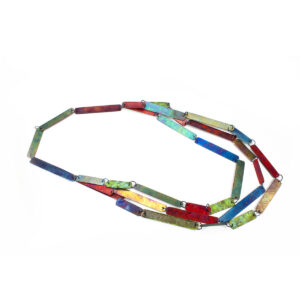
“blue pods“ necklace Titanium flame coloured One side is polished, one side rough
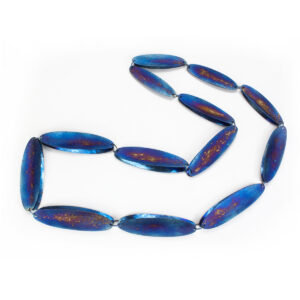
„green tulip“ necklace titanium flame coloured, silver chain
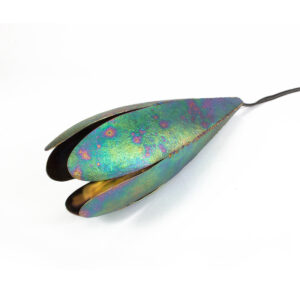
„green pebbles“ titanium flame coloured, silver, paint
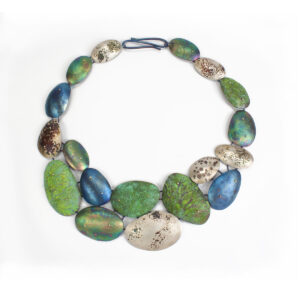
„pebbles beach“ silver, pigments, hidden glas inside
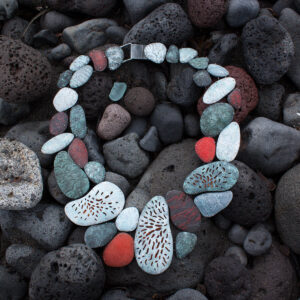
Transcript:
Like nature itself, Nicola Heidemann’s jewelry can never be completely controlled. Using heat coloring techniques to create jewelry that evokes the beauty of the natural world, Nicola allows the material to tell her when the piece is finished. She joined the Jewelry Journey Podcast to talk about the materials she uses the most; why the ability to touch and carry her jewelry is central to her work; and why she hopes her jewelry bonds the wearer to nature. Read the episode transcript here.
Sharon: Hello, everyone. Welcome to the Jewelry Journey Podcast. This is the first part of a two-part episode. Please make sure you subscribe so you can hear part two as soon as it’s released later this week.
Today, my guest is Nicola Heidemann. She’s based in Germany, in Stuttgart, and she founded Nicola Heidemann Jewelry. I had first seen her at Schmuck before Covid. Schmuck, for those of you who don’t know, is the annual—I call it a trade show. Everybody knows it. I ask if you’re going to Munich or you’re going to Schmuck, and it’s the same thing. She was at a table at a popup that was all over the city, but there were a couple of people who had stopped to look at her jewelry. I would have missed her totally, but it was this small group that made me curious. I stopped to look, and I was really taken by the blues and greens in her work and the shapes she uses in crafting her jewelry. It’s also very deceptive. If you were to put it down on grass or on stones at the beach, it would be hard to tell her jewelry apart. It also looks heavy and it’s very, very light.
Today, she’ll tell us about her philosophy when it comes to both jewelry and metal and also nature, which plays a very important part in what she does. Welcome to the podcast, Nicola.
Nicola: Thank you, Sharon. Thank you for inviting me. Hi.
Sharon: Hi. You have a lot of inspiration from nature. Do you see colors in everything, other colors? You have so much that’s blue and green. You get inspiration from nature, but is it from all nature, or only the sky or the ocean, which is blue, and grass?
Nicola: Nature for me is indeed the most important inspiration. I think our sense of beauty is informed by nature, by the shapes you find in nature, by the colors, the color combinations. That’s my idea, to work in color combinations which you could find in nature as well. In nature, you don’t have monochromatic colors or colors which are not matching to each other. This is my inspiration indeed.
Sharon: I saw some red, for instance. It’s unusual for you. I saw a piece that had red in it. The inspiration for the red, and you have on a purple dress, do those come from nature or do they come from other places?
Nicola: Yes, of course. Reds you can find in flowers or in volcanic soils. Red is quite a common color in nature, but the reason why you don’t see red in so many pieces of mine is that my main material I use is titanium. Titanium has a big range of plain color possibilities which don’t include red, so I can make it blue and green and turquoise and yellowish, but red, I can’t reach. So, for the red pieces, I must use different techniques to get it.
Sharon: I’m going to jump around because you said that titanium has a lot of different colors and that it gives you a lot of different ideas, new ideas. Do you write those down because there are so many of them?
Nicola: I don’t write down. I draw a lot, but quite often the material is driving me through the process because there are some parts of my work which I can’t control, and that’s the heat coloring. I know it’s quite good what I do, but there are some uncontrollable effects. Sometimes the material tells me, “O.K., that’s the right color. Stop now.”
Sharon: If you’re doing a piece and you see a color—let’s say a gold that you didn’t intend the piece to be—do you file that away mentally or in your drawings and think, “I’m going to try that next time or another time”? Do you think about it?
Nicola: Yes, sometimes I stop immediately and say, “O.K., this piece has to be gold now because it’s such a beautiful gold.” I will stop because, when you stop the process of heating, the color remains. When I see it’s so beautiful, I decide, “O.K., this piece has to be gold now.” I leave the decision sometimes to the material or to the—I don’t know the word—for the moment.
Sharon: Do you go from a blue color to a green color to a gold color? I don’t know how the process works. As you’re heating, do you see blues and then greens and then golds?
Nicola: There’s a shade of colors, a color palette. It starts with gold from a magenta. Then it’s a lilac or violet, then it’s blue, then it’s turquoise, then it’s yellowish and then the process again starts to go to pink, magenta, and then the green appears. It’s a long task, and it depends on the temperature of the piece you’re heating.
Sharon: You had mentioned the term shibuichi. I don’t know how to say it.
Nicola: Shibuichi is a Japanese alloy which is one part of the Mokume Gane technique. It’s the dark alloy of this Mokume Gane. Shibuichi is an alloy with a lot of copper, and it’s also possible to heat color it. It has a warm red when you heat color it.
Sharon: So, it’s a metal?
Nicola: Yeah, it’s a metal alloy. It’s 70% copper and 30% silver.
Sharon: Is it something that you go to your supplier and say, “I want to make this and I need some,” or do you make it?
Nicola: No, I order my metals from my supplier. I order titanium and copper and silver as wire and sheets.
Sharon: How often do you start new pieces?
Nicola: Pretty often. Sometimes a piece takes years because I’m not content, and I think, “No, it’s not going to be good.” Sometimes I leave a piece for years, and then I see it again and put it out and say, “Now I have the idea. Now I can finish it.” I have a lot of pieces parallel which are not finished yet but in the making.
Sharon: Some of your pieces have dimension. Your pebble pieces seem to be folded over. What made you decide to add dimension?
Nicola: It’s like in nature. On a pebble beach you have really beautiful, different shapes, and a volume is needed, I think, to tell the story I want to tell. Sometimes I want to touch a piece. I want to have it in my hand and hold it, and the volume is filling up my hand.
I don’t know if I’m describing it right. For me, it’s all about understanding nature. There are different terms for the word understanding in German. One is verstehen. It’s like in English, understanding, but the other is begreifen, which literally means to touch it with your hand. A very important point in understanding nature is to touch it, to have this haptic experience.
Sharon: Do you live near the beach? Do you see pebbles just when you go outside?
Nicola: I live near a river beach. I often stroll around and collect pebbles. I did it when I was a child. I think that’s also a reason why I love to make jewelry. It’s something small you could put in your pocket and take with you. It’s a beautiful pebble or a shell or a piece of wood, and for me, it’s like jewelry. It’s the same. It’s a beautiful piece you can take with you. You are allowed to touch it with your hands. You can take it with you everywhere you go.
Sharon: Is some of your jewelry like that? Do you intend to make a piece of jewelry that somebody sticks in their pocket and knows is there?
Nicola: Sometimes, yes. They are allowed to do anything with a piece. Of course, it’s also possible to wear it, but for me, this haptic sensation is so important and this idea to take it with you.
Sharon: To take the jewelry with you.
Nicola: Yes.
Sharon: Do you feel it? Let’s say you’re feeling stressed or talking to somebody and trying to explain something. If you feel the piece in your pocket, you feel more confident. That’s what I’m looking for, confidence. Do you feel that?
Nicola: Yes, but most of the time, I touch the pieces. A ring, for example, I always play with a ring on my fingers, or I play with a chain around my neck. It’s like a talisman, the piece, to be more relaxed or comfortable. The quality of the surface is often—some pieces are rough; some pieces are polished. I like the sensation the pieces cause on my fingertips when I touch them. So, yes.
Sharon: Is that why some of your jewelry is smooth and some of it’s a little rougher? Is it to imitate nature, to imitate what you see?
Nicola: Yeah, maybe not to imitate, but to give a hint or to give a memory, to let people remember that we are part of nature. I think that’s my story, to give a person the synch. We are part of nature and beauty is nature.
Sharon: That’s interesting. Did you have that mindset when you started making jewelry or did you come to that?
Nicola: When I was a child, I collected small pieces. I built miniature landscapes in the garden, and when I painted, I painted miniature pictures of landscapes or trees. It always was a connection to nature. This is my background.
The idea to make jewelry was just to take these beautiful pieces with me. I wanted to keep them with me and to have them always with me. I’m not a trained goldsmith, so when I start a piece, sometimes I don’t think about what it is. It’s not going to be a necklace or a bracelet. First of all, it’s an idea of a shape, a color, a face. Then later the idea is, “O.K., I want to make a necklace with this or a bracelet.”
Sharon: You don’t start out where you have gold and you think, “I’m going to make a chain with it.” You shape it and it starts to take a form.
Nicola: It’s the other way around. Jewelers normally have some gold; they make a chain and that’s it. For me, first of all, the idea is important. Then comes the function and the wearability.
Sharon: I’m asking you because you have your pebble collection or your series of pebble jewelry, which is very interesting. Do you see pebbles and think, “I want to make a piece just like that”? How do you think about it?
Nicola: I think it’s more a love affair. I love pebbles. I love the different shapes and faces. Also on a pebble beach, there’s this collection of so many different pebbles. All of these come from different regions, and nevertheless they are matching or they are beautiful in this collection on a certain beach. For me, it’s a desire, a desire for nature’s beauty.
Sharon: It’s interesting because you show some of your pieces lying on the pebbles, and it’s hard to tell what’s your work and what’s nature’s work. Is that what you were after, to have it blend in?
Nicola: I am content because I think my jewelry is almost as beautiful as nature is. Then I’m happy.
Sharon: Is that what you mean by saying that the heat colors are harmonious? I didn’t understand what you meant by harmonious.
Nicola: Yeah, that’s true. When you fire this metal—and it doesn’t matter which metal. The heat colors of copper and the heat colors of titanium are matching or harmonious with each other. It’s a harmonious match. It’s like in nature. You don’t have any color combinations in nature.
Sharon: Are you saying that sometimes you work with copper and sometimes it’s titanium, and you get a gold color and they’re similar to each other? Is that what you’re saying?
Nicola: Yes, similar or matching in a way. They are not fighting each other. They are harmonious.
Sharon: Can you give us an example where you found something very harmonious that you didn’t think would be harmonious when you started out?
Nicola: I made a series of earrings. I started with silver, and I sprinkled some copper inside and I heat colored it. It’s a white ground with sprinkles of heat-colored copper. The top of this earring is a polished titanium, also heat colored. The colors are different, but in a way harmonious. It’s three different metals, but they are playing a wonderful game together.
Sharon: Did you heat the silver first alone and then you sprinkled it?
Nicola: Yeah.
Sharon: You did. And then you played with it to see—
Nicola: Yeah, I played with it. All the silver or the metals are playing with me.
Sharon: You also said that the incomplete fascinates you. What did you mean by that?
Nicola: Sometimes you tell a story, and I probably tell stories with my jewelry as well, but it’s not always visible. Sometimes I have a pebble with holes, and inside you can see a sparkle, but it’s not describing or explaining on the first side what it is. Sometimes people say, “Oh, what’s inside? What is it?” and I cannot explain what it is.
For me, secrets are really important. Secrets mean that you are curious; you want to explore something, but a piece of the secret always remains. It’s not perfectly explained, but it makes us curious.
Sharon: Are there pieces you make with a secret that only you know or only the wearer knows?
Nicola: Maybe that. It’s triggering questions. Maybe they find an answer or not, but it’s a hint, and a hint always triggers you to think about it and to communicate. Sometimes my jewelry is causing communications because the people ask, “What is it, and why is it so shimmering inside? Why does it sound so interesting?” It starts a communication, and that’s an effect I really love.
Sharon: That’s really interesting. There’s not a lot of jewelry that facilitates communication. Why do you think of yourself as a creator and not a collector?
Nicola: Or the other way around.
Sharon: You think of yourself as a collector. I pose the question: why do you think of yourself as a collector and not a creator?
Nicola: Because there’s always a part which I can’t control. I collect some ideas. I collect pieces and I put it together, but I’m not able to control every step of the work. That’s why I say I’m a collector. Sometimes I put some ideas together, some techniques, and then something is growing and I’m not responsible for every part of it. Maybe that’s the answer.
Sharon: It seems like you have a lot of ideas. I wonder how you keep track of them. If you wake up one morning and you can’t think of anything to do, do you go back into your mental file drawer and think, “Well, I wanted to try this”? How do you work?
Nicola: Yeah, it’s working quite easily. Sometimes I make drawings of my ideas, but most of the time, I really live with it. I go to bed with it and in the morning, I think about it. It’s a bit like a permanent meditation. I am lucky enough to spend all my time with that. So, it’s quite easy for me.
Sharon: When you sketch, what are you sketching? Are you sketching colors or pieces?
Nicola: I used to sketch more often and with colors, but for now, I sketch only with a pencil. Sometimes I draw some connections, sometimes technical things, how I can connect some pieces.
Sharon: We will have photos posted on the website. Please head to TheJewelryJourney.com to check them out.

